Stone, minerals and semiprecious of the world stone
Native elements: Gold, Aurum -->rus
 Diagnostic cart.
Diagnostic cart.
Native gold is in a quartz, Brusson found in a mine
Au
Crystal structure cube
Hardness on the Mohs scale 2,5-3
Specific unit weight mass 15,5-19,3
Cleavage non-existent
Fracture, break hooked
Colors yellow, gold gold yellow or yellow-brass
Colors in powder triturate yellow, gold
Glance (glitter, glare) metallic
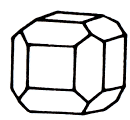
 Gold. Glance (glitter, glare) metallic, opaquely. Colors golden-yellow, gold. A line is golden-yellow. Fracture, break hooked. Malleable. Cleavage non-existent. Appears in quartz vein, lode, mines (native), accumulates in mineral deposits (gravel mine deposit). Crystals (cube Crystal structure) are rare.
Gold. Glance (glitter, glare) metallic, opaquely. Colors golden-yellow, gold. A line is golden-yellow. Fracture, break hooked. Malleable. Cleavage non-existent. Appears in quartz vein, lode, mines (native), accumulates in mineral deposits (gravel mine deposit). Crystals (cube Crystal structure) are rare.
Gold a dense inert bright yellow element that is the most malleable and ductile metal, occurring in rocks and alluvial deposits: used as a monetary standard and in jewellery, dentistry, and plating. The radioisotope gold-198 (radiogold), with a half-life of 2.69 days, is used in radiotherapy. Symbol: Au; atomic no.: 79; atomic wt.: 196.96654; valency: 1 or 3; relative density: 19.3; melting pt.: 1064.43oC; boiling pt.: 2857oC.
More frequent lamellar tabular or prolate as a wire individuals, dendrites, nuggets. Used for making of jeweller decorations and as a currency metal, and also in electronics. Application of leaf gold is traditional in architecture before (during restoration of palace buildings, for gilding of domes and spires). Deposit minefield mine field occurrence subsoil: in South Africa, in Siberia (CIS), on Alaska (USA).
Crystals: always rare and ultrafine. Their form is cube, octahedral and rhombic-dodecahedron shape (diamond forms), sometimes unusually extended. Usually have a form of plates and bodies of wrong outlines, massive or spongy, or aggregates of grains. In a native kind composition is not chemically clean, because gold forms alloys with other metals.
Diagnostic indication.
Gold can be distinguished from a Pyrite and chalcopyrite (similar in color) on malleability, capabilities at shots only flattened, bend, but not to disintegrate on wreckages. It differs from sparkles mica, meetings with him together in sand and having gold yellow brilliance, as these spangles very much lights and easily disintegrate on cleavage. Gold does not dissolve in acids, except for "aqua regis (chloroazotic acid)" - mixture of nitric and hydrochloric acid.
Origin provenance genesis.
Gold be found in primary deposits - high temperature hydrothermal vein, lode, mines. It is accompanied mainly by a Pyrite and Arsenopyrite. Other area of distribution is the second deposits, which appear at destruction of primary deposits and decomposition of minerals, containing gold. In such terms it accumulates as grains of sand, extended particles and nuggets of round-off or wrong form.
Deposit minefield mine and use.
The deposits of California (USA) are most known. After their opening in 1848 a "gold-fever" began in Australia, where found a few separate nuggets weighing in ten of kilograms, and then in Klondike, on the border of Alaska and Canada. Besides the use on jeweller business and coinage of chinks, gold is used in industry and medicine (as salts), in particular in stomatology.

Gold (schlich from glacial deposits). Iksha, to to P. from Moscow, Russia, CIS. A photo: © A.A. Evseev.
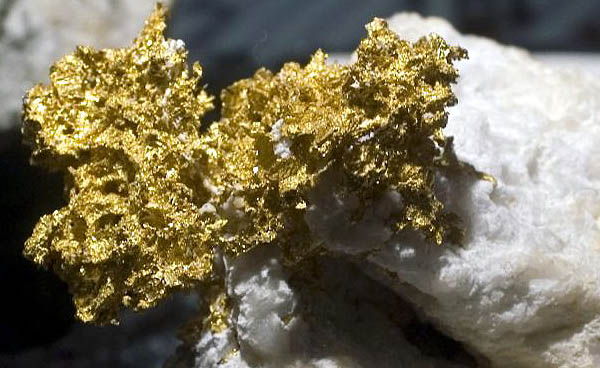
Gold. "Nadezhda", Brusson, Valle-Daosta, lived, Sitting down. Italy, EU. A photo: © A.A. Evseev.
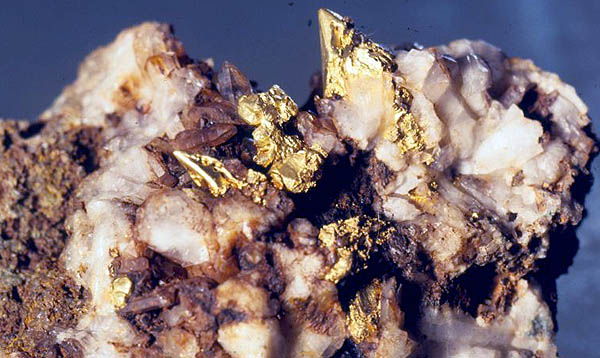
Gold (crystals to 0,8 sm), Quartz. Transilvaniya, Romania, EU. A photo: © A.V. Sverdlov.
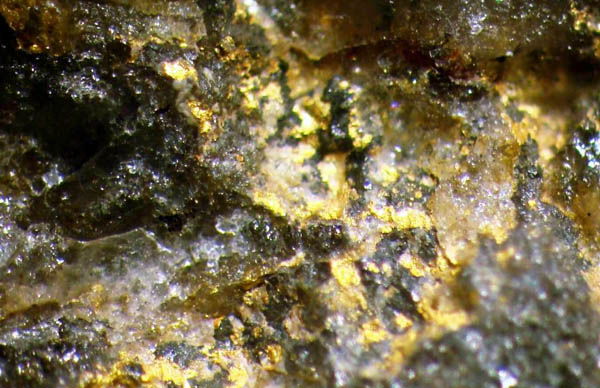
Gold in pebble of quartz from Bitak conglomerates. Simferopol, Crimea (Ukraine, CIS). A photo: © A.I. Tischenko.
Gold yellow high-silvery - one of the first finds of native natural gold in pebble of quartz (smoke-coloured quartz black morione - on a photo, umber and honey-brown tones of stone) from bitakskiy conglomerates is Simferopol (South outskirts), baring of conglomerates of bitakskiy winded (lower - middle jurassic, lower - lower bayosse) in around dikes of the Simferopol storage pool, in pebble of brownish quartz is visible xenomorphic yellow gold on cracks in a quartz. Gold associates with dark-steel-grey telluride of Bi (in the stage of study) is the first find in Crimea of telluride (above).
Below is the first find in Crimea of gold in an association with a chrysocolla (greenish-turquoise) - Opolznevskoe multimetallic complex ore display (south-west Crimea, Khyr to the west пос. Blue Bay). Gold is observed in the area of oxidization as xenomorphic grains of yellow in a turquoise chrysocolla. Below is kick-up (especially last years) gold of Russian gold-mining, nugget (Ural, Russian Federation, CIS).

Gold in a chrysocolla. Opolznevskoe multimetallic complex ore display,, Crimea Khyr (Ukraine, the CIS). A photo: © A.I. Tischenko.
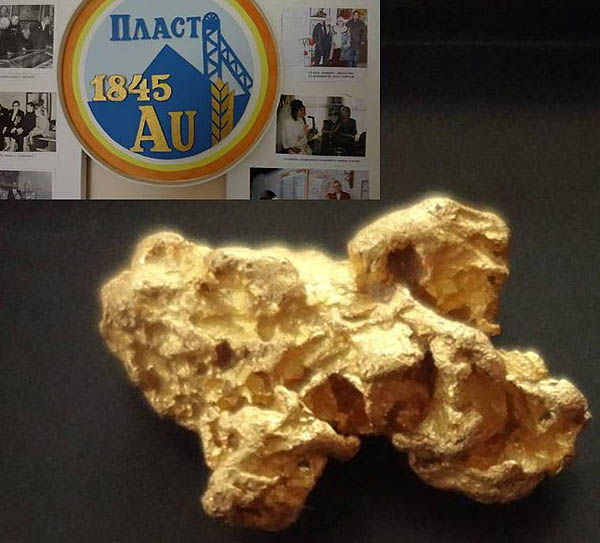
Gold (5,5 g). Eleninskaya mineral deposit, Kamenka, Ю. Ural, Russia, CIS. A photo: © A.A. Evseev.
Gold strengthens the bactericidal action of silver (silver destroys the shells of bacteria, gold destroys mitochondrion, mitochondrium). Metallic gold not so toxically for the organism of people, unlike organic and other derivates (the chloride of gold is toxic - in salt water, paints water in green turquoise). In homoeopathic (small) doses renders a antisclerosis action. Participating of gold is possible in normalization of immune processes in an organism (treat oneself from colds and acute respiratory disease, ARD - in the lagoons of coast of the Pacific ocean).
Gold is needed: at polyarthritis, osteochondrosis, parodontosis, amphodontosis, deforming arthritis, atherosclerosis, high blood pressure, diseases of hepar, depressions. Preparations on the basis of salts of gold (marine salt of Halite, Mine Rock Salt, contains gold - as a microelement) are used in therapy of patients rhematoid and psoriasis arthritises, syndrome of Felti, to lupus erythematosus (tuberculosis skin, cutis). Preparations of gold are entered both inward and parenterally, as colloid solutions (chrysotherapy). Gold can be brought over to the processes of fastening of hormones in tissues.
Application of preparations of gold is related to the large number of side effects and contra-indications (frequent fights of imaginary patients are in hospitals and policlinics - for bullions and nuggets, "imaginary patient", from stomatology and ортодонтов, dental crowns - to oncology and chemotherapy, solutions, gilt). Convey - with a black arsenic. Bring gold - and all "are" ("gold-fever") ill them, imaginary gold-diggers appear in a hospital - with metal detector (metal finder), it is not medicine (you are robbed) !!
At poisoning: there are symptoms of oppressing of CNS, pains on motion nerves (neuritises, "pain nerve"); appearance of sickly spots on a skin; increased perspiration, ostealgia, joints, muscles, edemata of feet; conjunctivitis; aplastic hypogenesis of marrow; pancytopenia (leukopenia, thrombocytopenia), degrowth body. Radio-active gold (198Au) is used at an oncotherapy and, foremost, shrine of lights. Poisoning gold is the phenomenon rare (exterminating oceans, saline lands, gold mines).
The mechanism of toxicness of ions of gold is based on affinity of this element to the sulfhydryl groups of albumens, as a result gold inhibit SH-ferment, enzyme. This mechanism will be realized at treatment of patients a pseudorheumatism, when introduction of preparations of gold results in the decline of activity of the sulfhydryl systems and enzymatic complexes of leucocytes, providing diminishing of concentration of rhematoid factor.
Waters of ocean are contained by the variable amounts of gold (from tracks - to 65 мг/t) - poisoning salt water caused poisoning chemically-soluble gold ("illness of papuan"). Food sources of gold: grains, leaves and corn-stalks (goldish). There is an about 10 mg of gold in an organism, a half is concentrated in bones. Distributing of gold depends on solubility of his compounds. Colloid compounds accumulate in livers, soluble - in buds (cinnabar buds).
